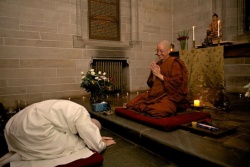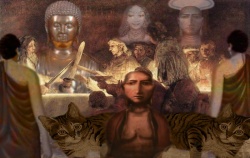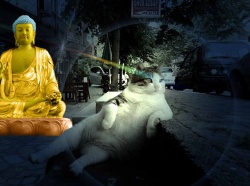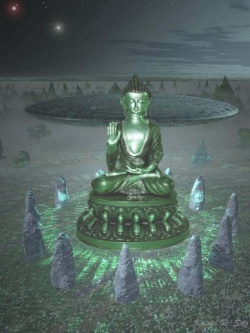Difference between revisions of "Introduction to Mahamudra Meditation"
(Created page with " <poem> Introduction to Mahamudra Meditation by Shamar Rinpoche A teaching given by Shamar Rinpoche at KKBC, {{Wiki|Singapore}}, on 22 Jan 2001 Here...") |
|||
| (7 intermediate revisions by the same user not shown) | |||
| Line 1: | Line 1: | ||
| − | + | <nomobile>{{DisplayImages|3096|2472|4209|842|1224|1208|4465|1383}}</nomobile><nomobile>{{DisplayImages|3676|3279|1924|2064|622|3287|2727|3520}}</nomobile> | |
<poem> | <poem> | ||
Introduction to [[Mahamudra]] [[Meditation]] | Introduction to [[Mahamudra]] [[Meditation]] | ||
| Line 6: | Line 6: | ||
A [[teaching]] given by [[Shamar Rinpoche]] at KKBC, {{Wiki|Singapore}}, on 22 Jan 2001 | A [[teaching]] given by [[Shamar Rinpoche]] at KKBC, {{Wiki|Singapore}}, on 22 Jan 2001 | ||
| − | Here in {{Wiki|Singapore}} you do a lot of [[Chenrezig]] | + | Here in {{Wiki|Singapore}} you do a lot of [[Chenrezig practice]]. The [[Mahamudra meditation]] can be combined with the [[Chenrezig practice]]. It is called the [[Mahamudra]] and [[Maha Ati]] joint practice. |
| + | |||
| + | There is a particular [[lineage]] that combines the [[Mahamudra]] and the [[Chenrezig practice]] together. I will teach some of it today so that you will be able to practise both together. | ||
| − | Generally, in [[Vajrayana]] | + | Generally, in [[Vajrayana practice]] the [[visualisation]] of a [[deity]] is used as a means of [[purification]]. |
| + | |||
| + | We can use this as a way to attain [[enlightenment]] during this [[lifetime]]. In English, this is called the [[accomplishment stage]]: after the [[deity]] is absorbed into you, you try to focus on the [[nature of mind]]. | ||
| + | |||
| + | This [[meditation]] can influence what will happen at the [[moment]] of [[death]]: when you [[die]], you will become [[enlightened]] at once. [[Mahamudra]] and [[Maha Ati practice]] are one and the same. | ||
| + | |||
| + | When combined with the [[Chenrezig practice]], the [[Mahamudra meditation]] will have an effect on your [[death]], whereas the [[Chenrezig practice]] will have an effect on your [[life]]. | ||
| + | |||
| + | Consequently, if you practice both together, and if you practice diligently between now and the [[time]] you reach the [[bardo]], you may be able to reach [[enlightenment within the bardo]]. | ||
| + | |||
| + | (The [[Bardo]] is the [[intermediate state after death]]). | ||
| − | There are two stages in | + | |
| + | |||
| + | There are [[two stages in Vajrayana practice]]: | ||
| + | |||
| + | |||
| + | first the [[development stage]] and then | ||
| + | the [[accomplishment]] or [[absorption stage]]. | ||
| − | The practice of the [[development stage]] will {{Wiki|purify}} [[birth]] in the [[samsara]]. The [[absorption]] | + | |
| + | |||
| + | The practice of the [[development stage]] will {{Wiki|purify}} [[birth]] in the [[samsara]]. | ||
| + | |||
| + | The [[absorption practice]] will {{Wiki|purify}} [[death]]. After both the [[causes]] of [[birth]] and [[death]] are [[purified]], everything will be [[purified]] and one will be [[enlightened]]. | ||
| − | Through [[visualizing]] [[Chenrezig]], one's [[mind]] slowly becomes [[purified]]. As a result, it will no longer be [[reborn]] in the [[samsara]]. Unlike one's [[body]] or one's [[life]], the [[manifestation]] of [[Chenrezig]] does not arise from a [[dualistic]] [[mind]], [[negative karma]], [[emotion]], or from the [[ego]]. It springs from [[compassion]] and is aimed at liberating all [[sentient beings]]. In this way, we can say that one ([[manifestation]] of [[Chenrezig]]) is the method and the other (one's [[body]] or one's [[life]]) is the target. | + | |
| + | Through [[visualizing]] [[Chenrezig]], one's [[mind]] slowly becomes [[purified]]. As a result, it will no longer be [[reborn]] in the [[samsara]]. Unlike one's [[body]] or one's [[life]], the [[manifestation]] of [[Chenrezig]] does not arise from a [[dualistic]] [[mind]], [[negative karma]], [[emotion]], or from the [[ego]]. | ||
| + | |||
| + | It springs from [[compassion]] and is aimed at liberating all [[sentient beings]]. In this way, we can say that one ([[manifestation]] of [[Chenrezig]]) is the method and the other (one's [[body]] or one's [[life]]) is the target. | ||
| − | After the [[Chenrezig]] [[manifestation]] that you have created in your [[meditation]] has been absorbed into you, you yourself disappear, and only then do you go on to [[Mahamudra | + | |
| + | |||
| + | After the [[Chenrezig]] [[manifestation]] that you have created in your [[meditation]] has been absorbed into you, you yourself disappear, and only then do you go on to [[Mahamudra meditation]]. | ||
| − | In order to do the [[Mahamudra | + | |
| + | In order to do the [[Mahamudra meditation]] properly, one should know about the [[nature of mind]]. | ||
| + | |||
| + | |||
| + | [[Mind]] is neither [[form]] nor material. Neither does it [[exist]] as some kind of [[physical body]]. | ||
| + | |||
| + | |||
| + | [[Mind]] is a [[continuous flow of thought patterns]]. [[Thoughts]] arise, disappear and follow one another in rapid succession. One [[thought]] leads to another. | ||
| + | |||
| + | The origin of [[thoughts]] lies in the [[mind]]. [[Thoughts]] constitute the [[illusory aspect of the mind]]. | ||
| + | |||
[[Thoughts]] are countless, they flow just like [[water]] down a [[river]], every new instant brings along new [[water]]. With the [[mind]], every new instant brings along new [[thoughts]]. | [[Thoughts]] are countless, they flow just like [[water]] down a [[river]], every new instant brings along new [[water]]. With the [[mind]], every new instant brings along new [[thoughts]]. | ||
| − | On the surface, all our [[thoughts]] are different, but in [[nature]] they are all the same. Such is the [[nature of mind]]. Unlike {{Wiki|matter}}, [[mind]] has the ability to understand itself and to clear itself. [[Mind]] is [[pure awareness]]. Unlike {{Wiki|matter}}, [[mind]] has the power of [[knowing]] and [[feeling]]. Everything you see, hear or [[feel]] is first processed by the [[mind]]. The [[mind]] has the power to know, to understand, to realise and to create [[awareness]], but [[thoughts]] in themselves are all one and the same in [[nature]]. | + | On the surface, all our [[thoughts]] are different, but in [[nature]] they are all the same. |
| + | |||
| + | |||
| + | Such is the [[nature of mind]]. | ||
| + | |||
| + | |||
| + | Unlike {{Wiki|matter}}, [[mind]] has the ability to understand itself and to clear itself. | ||
| + | |||
| + | [[Mind]] is [[pure awareness]]. Unlike {{Wiki|matter}}, [[mind]] has the power of [[knowing]] and [[feeling]]. | ||
| + | |||
| + | Everything you see, hear or [[feel]] is first processed by the [[mind]]. | ||
| + | |||
| + | The [[mind]] has the power to know, to understand, to realise and to create [[awareness]], but [[thoughts]] in themselves are all one and the same in [[nature]]. | ||
| − | All [[thoughts | + | All [[thoughts are illusion]], like a [[mirror]], which reflects whatever it faces. If 100 [[people]] stand in front of it, the [[mirror]] will reflect every single one of them, but none of the faces reflected really [[exist]]. |
| + | |||
| + | All the [[thoughts]] in the [[mind]] are like the faces in the [[mirror]]. Each [[thought]] depends on its [[object]]; if there is no [[object]], there is no [[thought]]. | ||
| + | |||
| + | |||
| + | When the [[mind]] focuses on an [[object]], | ||
| + | |||
| + | a [[thought]] will arise, but it is like is a [[mirage]]. | ||
| + | |||
| + | Whatever one [[feels]], hears or sees through one's [[eyes]] immediately becomes a [[thought]] but they do not have any [[intrinsic existence]]. | ||
| − | [[Thought]] by itself can never [[exist]] because it depends on its [[object]], like when I look at two of these gentlemen here. One has a white beard, and the other does not. At this moment, the presence of these two gentlemen [[causes]] two [[thoughts]] to appear in my [[mind]] but they have no true [[existence]], they are just [[illusion]]. The [[minds]] of all [[beings]] are filled with [[thoughts]] related to external [[phenomena]] and this creates a lot of {{Wiki|confusion}}. | + | [[Thought]] by itself can never [[exist]] because it depends on its [[object]], like when I look at two of these gentlemen here. One has a white beard, and the other does not. |
| + | |||
| + | At this [[moment]], the presence of these two gentlemen [[causes]] two [[thoughts]] to appear in my [[mind]] but they have no true [[existence]], they are just [[illusion]]. | ||
| + | |||
| + | The [[minds]] of all [[beings]] are filled with [[thoughts]] related to external [[phenomena]] and this creates a lot of {{Wiki|confusion}}. | ||
| − | When one realises the [[true nature of the mind]], one will be free from [[dualistic]] [[thinking]]. One uses [[dualistic]] [[thinking]] when one touches, looks at something, or even when one imagines something: for example I can [[imagine]] that this lady here has the same beard as that man. Why? I can do that because my [[imagination]] is dependent on things [[existing]] and my [[mind]] can always think of everything that [[exists]]. | + | When one realises the [[true nature of the mind]], one will be free from [[dualistic]] [[thinking]]. |
| + | |||
| + | One uses [[dualistic]] [[thinking]] when one touches, looks at something, or even when one imagines something: for example I can [[imagine]] that this lady here has the same beard as that man. | ||
| + | |||
| + | Why? | ||
| + | |||
| + | I can do that because my [[imagination]] is dependent on things [[existing]] and my [[mind]] can always think of everything that [[exists]]. | ||
| − | Whenever one [[thinks]] of something, one does so in a [[dualistic]] way. The [[enlightened]] state of the [[mind]] is when it is completely free from all these [[dualistic]] [[thoughts]]. In that state, the [[mind]] can never be confused. | + | Whenever one [[thinks]] of something, one does so in a [[dualistic]] way. The [[enlightened]] [[state]] of the [[mind]] is when it is completely free from all these [[dualistic]] [[thoughts]]. In that [[state]], the [[mind]] can never be confused. |
Such is the [[correct view]] or the correct [[understanding]] of the [[nature of mind]]. Keep this [[correct view]] as a support to your [[meditation]] and focus your [[mind]] on itself. There are two ways to do this: | Such is the [[correct view]] or the correct [[understanding]] of the [[nature of mind]]. Keep this [[correct view]] as a support to your [[meditation]] and focus your [[mind]] on itself. There are two ways to do this: | ||
| − | On the one hand, you can examine your [[mind]]; examine how it [[exists]] or is [[existing]]. Instead of allowing your [[mind]] to be distracted by external [[objects]], focus your [[mind]] on itself and try to [[grasp]] its [[true nature]]. Examine each and every one of your [[thoughts]], in order to see its real [[existence]]; ultimately you will come to realise that not one single [[thought]] [[exists]]. That is one way of getting closer to [[grasping]] the [[nature of mind]]. | + | |
| + | On the one hand, you can examine your [[mind]]; examine how it [[exists]] or is [[existing]]. Instead of allowing your [[mind]] to be distracted by external [[objects]], focus your [[mind]] on itself and try to [[grasp]] its [[true nature]]. | ||
| + | |||
| + | Examine each and every one of your [[thoughts]], in order to see its real [[existence]]; ultimately you will come to realise that not one single [[thought]] [[exists]]. That is one way of getting closer to [[grasping]] the [[nature of mind]]. | ||
| + | |||
On the other hand, you can rest your [[mind]] on itself and keep it free from [[thought]], focusing on nothing but keeping that [[awareness]]. | On the other hand, you can rest your [[mind]] on itself and keep it free from [[thought]], focusing on nothing but keeping that [[awareness]]. | ||
| − | These are the two ways that you can use to focus on your [[mind]]. You can do these two practices alternately. Sometimes when you get bored with resting and just keeping that [[awareness of the mind]], you can change to the more analytical way of examining the [[mind]]. In order to do that, first try to create a very sensitive [[thought]], like [[anger]]. A good [[practitioner]] or [[meditator]] often uses his [[emotions]] as the [[objects]] of his [[meditation]]. [[Emotion]] is very sensitive and easy to focus on. When you focus on [[emotion]], you can analyse its [[nature]] and through it you will get a first-hand [[experience]] of the [[nature]] of that [[emotion]]. You will realise that it does not [[exist]]. In this way [[emotion]] is useful. [[Meditators]], instead of [[abandoning]] [[emotions]], use them as [[objects]] of focus in their [[meditation]]. This does not develop [[emotion]] but on the contrary makes it disappear. In that way, any sensitive [[feeling]] can be used for [[analytical meditation]] and the result of that is the [[experience]] of [[empty]] clear [[awareness]], the [[true nature of mind]]. | + | These are the two ways that you can use to focus on your [[mind]]. You can do these two practices alternately. |
| + | |||
| + | Sometimes when you get bored with resting and just keeping that [[awareness of the mind]], you can change to the more analytical way of examining the [[mind]]. | ||
| + | |||
| + | In order to do that, first try to create a very [[sensitive]] [[thought]], like [[anger]]. | ||
| + | |||
| + | |||
| + | A good [[practitioner]] or [[meditator]] often uses his [[emotions]] as the [[objects]] of his [[meditation]]. [[Emotion]] is very [[sensitive]] and easy to focus on. | ||
| + | |||
| + | When you focus on [[emotion]], you can analyse its [[nature]] and through it you will get a first-hand [[experience]] of the [[nature]] of that [[emotion]]. | ||
| + | |||
| + | You will realise that it does not [[exist]]. In this way [[emotion]] is useful. [[Meditators]], instead of [[abandoning]] [[emotions]], use them as [[objects]] of focus in their [[meditation]]. This does not develop [[emotion]] but on the contrary makes it disappear. | ||
| + | |||
| + | |||
| + | In that way, any [[sensitive]] [[feeling]] can be used for [[analytical meditation]] and the result of that is the [[experience]] of [[empty]] clear [[awareness]], the [[true nature of mind]]. | ||
| − | This is [[vipassana]] [[meditation]]. [[Enlightenment]] comes from the practice of [[vipassana | + | This is [[vipassana]] [[meditation]]. [[Enlightenment]] comes from the practice of [[vipassana meditation]]. |
| + | |||
| + | The different levels of [[Vipassana]] [[meditation]] are [[taught]] in the [[Mahamudra]]. | ||
| + | |||
| + | "[[Mahamudra]]" is the [[name]] of the [[subject]]. Many [[books]] on the "[[Mahamudra]]" provide explanations on [[Vipassana]] [[meditation]]. All types of [[Vipassana]] [[meditation]] are the same in [[essence]]. | ||
| − | "Semngo" is the [[Tibetan]] [[word]] for [[meditation]]. "Sem" means " [[mind]]"; "ngo" means " face, semngo means '[[nature of mind]]' or "[[meditation | + | |
| + | |||
| + | "Semngo" is the [[Tibetan]] [[word]] for [[meditation]]. | ||
| + | |||
| + | "[[Sem]]" means " [[mind]]"; "[[ngo]]" means " face, [[semngo]] means '[[nature of mind]]' or "[[meditation on the nature of mind]]". | ||
| + | |||
| + | |||
| + | By focusing on your [[mind]], you will know and realise its [[nature]]. | ||
| + | |||
| + | When the [[purity]] of the [[mind]] emerges, the [[illusory]] aspect will naturally disappear. And to develop the [[purity]] of [[mind]], your [[mind]] has to be free from [[thought]] and focused on itself. | ||
| − | There is a short cut method which consists in doing the [[Chenrezig]] | + | |
| + | |||
| + | There is a short cut method which consists in doing the [[Chenrezig practice]] first. | ||
| + | |||
| + | The [[Chenrezig practice]] is a condensed powerful method. Through the [[Chenrezig practice]], you enter into the "[[semngo]], the [[state of accomplishment of mind]]. | ||
| + | |||
| + | |||
| + | "[[Semngo]]" is very profound. [[Dharmakaya]] is "[[semngo]]", the "[[semngo]]" practice is the way to develop/realise [[Dhamarkaya]]. | ||
| + | |||
| + | [[Dharmakaya]] is within [[Semngo]]. The level of the [[Bodhisattva bhumi]] that you attain will depend on the [[degree]]/ level of the [[semngo]] that you have [[attained]] / [[realized]]. | ||
| + | |||
| + | When you attain the full [[accomplishment]] of the [[semngo]], you reach [[enlightenment]], or [[Buddhahood]]. | ||
| − | When doing the | + | When doing the [[semngo practice]] or even any other practice, [[discipline]] is very important. [[Discipline]] will {{Wiki|protect}} you from giving in to [[obstacles]]. For example when you do [[meditation]], the sitting position/posture is very important. |
| + | |||
| + | One must pay [[close attention]] to the seven points related to the correct sitting [[posture]] for [[meditation]]. | ||
| + | |||
| + | For [[semngo meditation]], for instance, you can rest your two hands on your lap with your right hand on top and your thumbs [[touching]] one another. | ||
| + | |||
| + | You can sit with your back on a higher level and your knees a little lower, in a sloping [[manner]]. Your spine has to be straight and you should hold your {{Wiki|stomach}} in. | ||
| + | |||
| + | This helps to give strength and clarity to your [[mind]]. Your [[eyes]], do not look up, but look down at an angle. | ||
| + | |||
| + | Keep your {{Wiki|mouth}} gently closed and {{Wiki|breathe}} mostly through your {{Wiki|nose}}. As for your {{Wiki|legs}}, you can sit in a full or half [[lotus position]], or with your left leg in and your right leg out like [[green Tara]].. | ||
| − | Eating moderately is also very important for [[meditation]]. [[Imagine]] that your {{Wiki|stomach}} is a cage or container; and you can fill two thirds of it with [[food]] and keep one third [[empty]]. You should never eat too much as it hinders [[meditation]]. Eating after 1.00 pm is not recommended as it will make the [[mind]] [[feel]] drowsy. Therefore, [[monks]] normally do not eat (some do not even drink) after 1.00 pm. Try to observe the above [[discipline]]. | + | |
| + | Eating moderately is also very important for [[meditation]]. [[Imagine]] that your {{Wiki|stomach}} is a cage or container; and you can fill two thirds of it with [[food]] and keep one third [[empty]]. | ||
| + | |||
| + | You should never eat too much as it hinders [[meditation]]. Eating after 1.00 pm is not recommended as it will make the [[mind]] [[feel]] drowsy. Therefore, [[monks]] normally do not eat (some do not even drink) after 1.00 pm. Try to observe the above [[discipline]]. | ||
| − | [[People]] who are used to eating a lot can follow the above [[discipline]] for one or two days, and they will not [[feel]] hungry. They need to be {{Wiki|patient}} as it will take them a couple of days to get used to new eating [[habits]]. If they [[feel]] hungry, they can eat some fruit or something light. Hunger is not really a problem. Hunger is not [[suffering]], and should not be given too much importance. [[People]] in {{Wiki|society}} believe that " you must eat or you will get hungry." They think that hunger is a [[suffering]] that one cannot bear. In actual fact, a little hunger is not a problem. Having nothing to eat is terrible but not experiencing a slight [[feeling]] of hunger. Proper [[diet]] is very important for [[meditation]]. | + | [[People]] who are used to eating a lot can follow the above [[discipline]] for one or two days, and they will not [[feel]] hungry. They need to be {{Wiki|patient}} as it will take them a couple of days to get used to new eating [[habits]]. |
| + | |||
| + | If they [[feel]] hungry, they can eat some fruit or something {{Wiki|light}}. Hunger is not really a problem. Hunger is not [[suffering]], and should not be given too much importance. [[People]] in {{Wiki|society}} believe that " you must eat or you will get hungry." | ||
| + | |||
| + | They think that hunger is a [[suffering]] that one cannot bear. In actual fact, a little hunger is not a problem. Having nothing to eat is terrible but not experiencing a slight [[feeling]] of hunger. Proper [[diet]] is very important for [[meditation]]. | ||
| − | When you practice [[meditation]] in this way, the resident [[Rinpoche]] here can [[guide]] you when you encounter any problem in the process. The result of [[meditation]] will actually depend on how diligently you practice. The more you practice, the quicker you get used to it. [[Mind]] is [[pure]], naturally [[pure]]; [[mind]] is [[empty]]. It is our [[Wikipedia:Habit (psychology)|habit]] to create [[thoughts]] and this habitual pattern is very strong. So what one has to do is to change that [[Wikipedia:Habit (psychology)|habit]] for another. When the [[mind]] is made {{Wiki|stable}} and not [[thinking]] too much, you will be able to develop this new [[Wikipedia:Habit (psychology)|habit]]: focusing the [[mind]] on the [[nature of mind]]; opening up the [[mind]] to see the [[nature of mind]]. It will not appear as a dull, dumb [[mind]] but as full of [[wisdom]]. [[Meditation]] does not require special timing; morning or afternoon are both fine, because your [[mind]] is always with you. [[Time]] does not make any difference to your [[mind]]. You need to [[sleep]], you have to work, but whenever you have some spare [[time]], use it for [[meditation]]. In this [[manner]], it will not take long for you to progress. | + | |
| + | |||
| + | When you practice [[meditation]] in this way, the resident [[Rinpoche]] here can [[guide]] you when you encounter any problem in the process. The result of [[meditation]] will actually depend on how diligently you practice. | ||
| + | |||
| + | The more you practice, the quicker you get used to it. [[Mind]] is [[pure]], naturally [[pure]]; [[mind]] is [[empty]]. | ||
| + | |||
| + | It is our [[Wikipedia:Habit (psychology)|habit]] to create [[thoughts]] and this habitual pattern is very strong. So what one has to do is to change that [[Wikipedia:Habit (psychology)|habit]] for another. | ||
| + | |||
| + | |||
| + | When the [[mind]] is made {{Wiki|stable}} and not [[thinking]] too much, you will be able to develop this new [[Wikipedia:Habit (psychology)|habit]]: focusing the [[mind]] on the [[nature of mind]]; opening up the [[mind]] to see the [[nature of mind]]. | ||
| + | |||
| + | It will not appear as a dull, dumb [[mind]] but as full of [[wisdom]]. [[Meditation]] does not require special timing; morning or afternoon are both fine, because your [[mind]] is always with you. | ||
| + | |||
| + | [[Time]] does not make any difference to your [[mind]]. You need to [[sleep]], you have to work, but whenever you have some spare [[time]], use it for [[meditation]]. In this [[manner]], it will not take long for you to progress. | ||
</poem> | </poem> | ||
| + | |||
{{R}} | {{R}} | ||
[http://sgforums.com/forums/1728/topics/398366 sgforums.com] | [http://sgforums.com/forums/1728/topics/398366 sgforums.com] | ||
[[Category:Mahamudra]] | [[Category:Mahamudra]] | ||
[[Category:Meditation]] | [[Category:Meditation]] | ||
Latest revision as of 06:07, 27 December 2015
Introduction to Mahamudra Meditation
by Shamar Rinpoche
A teaching given by Shamar Rinpoche at KKBC, Singapore, on 22 Jan 2001
Here in Singapore you do a lot of Chenrezig practice. The Mahamudra meditation can be combined with the Chenrezig practice. It is called the Mahamudra and Maha Ati joint practice.
There is a particular lineage that combines the Mahamudra and the Chenrezig practice together. I will teach some of it today so that you will be able to practise both together.
Generally, in Vajrayana practice the visualisation of a deity is used as a means of purification.
We can use this as a way to attain enlightenment during this lifetime. In English, this is called the accomplishment stage: after the deity is absorbed into you, you try to focus on the nature of mind.
This meditation can influence what will happen at the moment of death: when you die, you will become enlightened at once. Mahamudra and Maha Ati practice are one and the same.
When combined with the Chenrezig practice, the Mahamudra meditation will have an effect on your death, whereas the Chenrezig practice will have an effect on your life.
Consequently, if you practice both together, and if you practice diligently between now and the time you reach the bardo, you may be able to reach enlightenment within the bardo.
(The Bardo is the intermediate state after death).
There are two stages in Vajrayana practice:
first the development stage and then
the accomplishment or absorption stage.
The practice of the development stage will purify birth in the samsara.
The absorption practice will purify death. After both the causes of birth and death are purified, everything will be purified and one will be enlightened.
Through visualizing Chenrezig, one's mind slowly becomes purified. As a result, it will no longer be reborn in the samsara. Unlike one's body or one's life, the manifestation of Chenrezig does not arise from a dualistic mind, negative karma, emotion, or from the ego.
It springs from compassion and is aimed at liberating all sentient beings. In this way, we can say that one (manifestation of Chenrezig) is the method and the other (one's body or one's life) is the target.
After the Chenrezig manifestation that you have created in your meditation has been absorbed into you, you yourself disappear, and only then do you go on to Mahamudra meditation.
In order to do the Mahamudra meditation properly, one should know about the nature of mind.
Mind is neither form nor material. Neither does it exist as some kind of physical body.
Mind is a continuous flow of thought patterns. Thoughts arise, disappear and follow one another in rapid succession. One thought leads to another.
The origin of thoughts lies in the mind. Thoughts constitute the illusory aspect of the mind.
Thoughts are countless, they flow just like water down a river, every new instant brings along new water. With the mind, every new instant brings along new thoughts.
On the surface, all our thoughts are different, but in nature they are all the same.
Such is the nature of mind.
Unlike matter, mind has the ability to understand itself and to clear itself.
Mind is pure awareness. Unlike matter, mind has the power of knowing and feeling.
Everything you see, hear or feel is first processed by the mind.
The mind has the power to know, to understand, to realise and to create awareness, but thoughts in themselves are all one and the same in nature.
All thoughts are illusion, like a mirror, which reflects whatever it faces. If 100 people stand in front of it, the mirror will reflect every single one of them, but none of the faces reflected really exist.
All the thoughts in the mind are like the faces in the mirror. Each thought depends on its object; if there is no object, there is no thought.
When the mind focuses on an object,
a thought will arise, but it is like is a mirage.
Whatever one feels, hears or sees through one's eyes immediately becomes a thought but they do not have any intrinsic existence.
Thought by itself can never exist because it depends on its object, like when I look at two of these gentlemen here. One has a white beard, and the other does not.
At this moment, the presence of these two gentlemen causes two thoughts to appear in my mind but they have no true existence, they are just illusion.
The minds of all beings are filled with thoughts related to external phenomena and this creates a lot of confusion.
When one realises the true nature of the mind, one will be free from dualistic thinking.
One uses dualistic thinking when one touches, looks at something, or even when one imagines something: for example I can imagine that this lady here has the same beard as that man.
Why?
I can do that because my imagination is dependent on things existing and my mind can always think of everything that exists.
Whenever one thinks of something, one does so in a dualistic way. The enlightened state of the mind is when it is completely free from all these dualistic thoughts. In that state, the mind can never be confused.
Such is the correct view or the correct understanding of the nature of mind. Keep this correct view as a support to your meditation and focus your mind on itself. There are two ways to do this:
On the one hand, you can examine your mind; examine how it exists or is existing. Instead of allowing your mind to be distracted by external objects, focus your mind on itself and try to grasp its true nature.
Examine each and every one of your thoughts, in order to see its real existence; ultimately you will come to realise that not one single thought exists. That is one way of getting closer to grasping the nature of mind.
On the other hand, you can rest your mind on itself and keep it free from thought, focusing on nothing but keeping that awareness.
These are the two ways that you can use to focus on your mind. You can do these two practices alternately.
Sometimes when you get bored with resting and just keeping that awareness of the mind, you can change to the more analytical way of examining the mind.
In order to do that, first try to create a very sensitive thought, like anger.
A good practitioner or meditator often uses his emotions as the objects of his meditation. Emotion is very sensitive and easy to focus on.
When you focus on emotion, you can analyse its nature and through it you will get a first-hand experience of the nature of that emotion.
You will realise that it does not exist. In this way emotion is useful. Meditators, instead of abandoning emotions, use them as objects of focus in their meditation. This does not develop emotion but on the contrary makes it disappear.
In that way, any sensitive feeling can be used for analytical meditation and the result of that is the experience of empty clear awareness, the true nature of mind.
This is vipassana meditation. Enlightenment comes from the practice of vipassana meditation.
The different levels of Vipassana meditation are taught in the Mahamudra.
"Mahamudra" is the name of the subject. Many books on the "Mahamudra" provide explanations on Vipassana meditation. All types of Vipassana meditation are the same in essence.
"Semngo" is the Tibetan word for meditation.
"Sem" means " mind"; "ngo" means " face, semngo means 'nature of mind' or "meditation on the nature of mind".
By focusing on your mind, you will know and realise its nature.
When the purity of the mind emerges, the illusory aspect will naturally disappear. And to develop the purity of mind, your mind has to be free from thought and focused on itself.
There is a short cut method which consists in doing the Chenrezig practice first.
The Chenrezig practice is a condensed powerful method. Through the Chenrezig practice, you enter into the "semngo, the state of accomplishment of mind.
"Semngo" is very profound. Dharmakaya is "semngo", the "semngo" practice is the way to develop/realise Dhamarkaya.
Dharmakaya is within Semngo. The level of the Bodhisattva bhumi that you attain will depend on the degree/ level of the semngo that you have attained / realized.
When you attain the full accomplishment of the semngo, you reach enlightenment, or Buddhahood.
When doing the semngo practice or even any other practice, discipline is very important. Discipline will protect you from giving in to obstacles. For example when you do meditation, the sitting position/posture is very important.
One must pay close attention to the seven points related to the correct sitting posture for meditation.
For semngo meditation, for instance, you can rest your two hands on your lap with your right hand on top and your thumbs touching one another.
You can sit with your back on a higher level and your knees a little lower, in a sloping manner. Your spine has to be straight and you should hold your stomach in.
This helps to give strength and clarity to your mind. Your eyes, do not look up, but look down at an angle.
Keep your mouth gently closed and breathe mostly through your nose. As for your legs, you can sit in a full or half lotus position, or with your left leg in and your right leg out like green Tara..
Eating moderately is also very important for meditation. Imagine that your stomach is a cage or container; and you can fill two thirds of it with food and keep one third empty.
You should never eat too much as it hinders meditation. Eating after 1.00 pm is not recommended as it will make the mind feel drowsy. Therefore, monks normally do not eat (some do not even drink) after 1.00 pm. Try to observe the above discipline.
People who are used to eating a lot can follow the above discipline for one or two days, and they will not feel hungry. They need to be patient as it will take them a couple of days to get used to new eating habits.
If they feel hungry, they can eat some fruit or something light. Hunger is not really a problem. Hunger is not suffering, and should not be given too much importance. People in society believe that " you must eat or you will get hungry."
They think that hunger is a suffering that one cannot bear. In actual fact, a little hunger is not a problem. Having nothing to eat is terrible but not experiencing a slight feeling of hunger. Proper diet is very important for meditation.
When you practice meditation in this way, the resident Rinpoche here can guide you when you encounter any problem in the process. The result of meditation will actually depend on how diligently you practice.
The more you practice, the quicker you get used to it. Mind is pure, naturally pure; mind is empty.
It is our habit to create thoughts and this habitual pattern is very strong. So what one has to do is to change that habit for another.
When the mind is made stable and not thinking too much, you will be able to develop this new habit: focusing the mind on the nature of mind; opening up the mind to see the nature of mind.
It will not appear as a dull, dumb mind but as full of wisdom. Meditation does not require special timing; morning or afternoon are both fine, because your mind is always with you.
Time does not make any difference to your mind. You need to sleep, you have to work, but whenever you have some spare time, use it for meditation. In this manner, it will not take long for you to progress.















